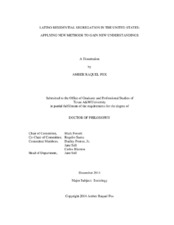Latino Residential Segregation in the United States: Applying New Methods to Gain New Understandings
Abstract
This study examines the residential outcomes of Latinos in major metropolitan areas using new methods to connect micro-level analyses of residential attainments to overall patterns of segregation in the metropolitan area. Drawing on new formulations of standard measures of evenness such as the Dissimilarity Index and the Separation Index, I conduct micro-level multivariate analyses using the restricted-use census microdata files to predict segregation-relevant neighborhood outcomes for individuals by race. I term the dependent variables segregation-relevant neighborhood outcomes because the differences in average outcomes for each group on these variables determine the values of the aggregate measures of evenness. This approach allows me to use standardization and components analysis to quantitatively assess the separate contributions that differences in social characteristics and differences in rates of return make towards determining the overall disparity in residential outcomes – that is, the level of segregation – between Whites and Latinos.
Based on my micro-level residential attainment analyses I find that for Latinos, acculturation and gains in socioeconomic status are associated with greater residential contact with Whites, in agreement with spatial assimilation theory, which promotes lower segregation. However, my standardization and components analyses reveals that a substantial portion of White-Latino disparities in residential contact with Whites can be attributed to differences in rates of return; that is White-Latino differences in the ability to translate acculturation and gains in socioeconomic status into more residential contact with Whites. This can be interpreted as the role of discrimination which is emphasized by place stratification theory. Therefore I conclude that while members of minority groups can make gains in residential outcomes that reduce segregation by attaining parity with Whites on social characteristics as spatial assimilation theory would predict, a substantial disparity will persist as Latinos cannot translate those gains into greater contact with Whites at the rate that Whites can. At the aggregate level of analysis, this means that White-Latino segregation remains substantial even when groups are equalized on social and economic characteristics.
Citation
Fox, Amber Raquel (2014). Latino Residential Segregation in the United States: Applying New Methods to Gain New Understandings. Doctoral dissertation, Texas A & M University. Available electronically from https : / /hdl .handle .net /1969 .1 /154197.


